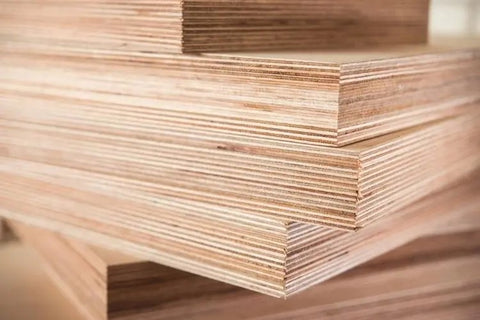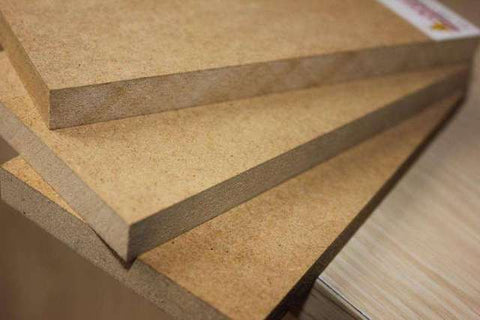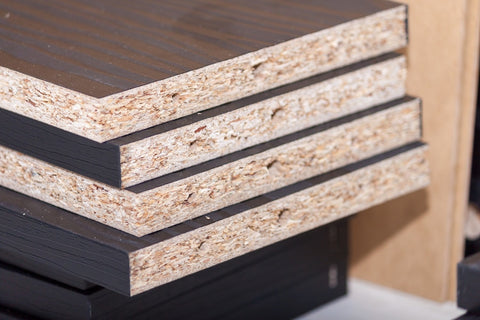Melamine faced chipboard, often abbreviated as MFC, is a versatile and widely used material in the world of furniture manufacturing. With its durability, affordability, and decorative capabilities, it has become a popular choice for both residential and commercial projects.
1. What is Melamine Faced Chipboard?
Melamine faced chipboard is an engineered wood product made by combining wood particles or chips with a resin adhesive. The resulting board is then covered with a melamine laminate, which provides it with aesthetic appeal and protection against wear and tear. As it is manufactured, it's a kind of engineered wood.
2. Why MFC (engineered wood) was invented?
Before being made into furniture, the trees need to go through some processes, such as cutting and milling, to reach usable sizes and shapes. Then the wood will become the standard sized material, which is called dimensional lumber. Dimensional lumber is usually a long, flag-shaped board with square edges. However, dimensional lumber usually has a limited board width because trees only grow to a certain width. Thus, multiple boards need to be joined together to form a panel with strong durability for manufacturing. But this process is very hard to complete.
To solve this problem, someone came up with this idea: to peel trees into layers and particles, then stack and glue a bunch of them together into a dimensional board with a certain length, width, and thickness. This is what we usually call "engineered wood".
3. Some commonly seen engineered wood: MFC, MDF, and plywood.
All of them are considered engineered wood and combined with additives. But there are several differences.
Plywood is formed of thin wood layers, so it looks more like real wood. It is very durable and won’t soak up water or swell easily, compared to MFC and MFD. But the price is comparatively more expensive.

MDF (medium density fiberboard) is a combination of wood fibers, a material that consists of recycled leftovers from when solid wood was cut. These fibers are combined with wax and resin, then pressure and high temperatures are applied in order to form panels. Thus, MDF has a higher density board than MFC and plywood in theory, and it has less reaction to moisture than MFC. But it may make terrible dust when being cut.

MFC (melamine faced chipboard) is manufactured from wood chips and pressed in sheets by high pressure. The finished board is then cut to shape and size, edged with a banding machine to protect the edges, and added melamine layers to the surface.
The quality of MFC mainly depends on the density of the board. Many domestic furniture companies use low-density board, which is light. Most commercial-grade furniture is made of a dense board, which can stop the boards from flexing and bending and also give them better stability and toughness.

4. Durability and Strength
MFC vs solid wood
Lots of people think solid wood is the best. Actually, it is not completely true, because the standard of “the best” depends on the needs. Solid wood is good, but it tends to be expensive and vulnerable to both heat and cold. Also, it is likely to suffer from termites, woodworms, and other pest infestations.
On the contrary, MFC is hard to both flex or crack. Adding glue makes it pretty strong and heavier than solid wood. The melamine laminate acts as a shield, making the board resistant to scratches, moisture, heat, and stains. This makes it suitable for heavy-duty applications in kitchens, bathrooms, and high-traffic areas, and can last for 10 years under normal use. And it is also good for mold making because of the glossy surface.
MFC vs MDF
Compared with ordinary boards, the internal structure of MDF is relatively fine, so it is not easy to fix with nails. To put it differently, MFC's ability to hold nails and screws is better than MDF's. And MDF is more prone to deformation under the same compression density and load-bearing environment, so its load-bearing capacity is relatively poor. Thus, it has a higher requirement for processing accuracy and technology when producing MDF. While MFC doesn't have such an issue.
5. Harmless
MFC has characteristics such as high temperature resistance, acid and alkali resistance, moisture resistance, and fire resistance. The chemical properties of MFC determine its stability and is not volatile under normal conditions. Therefore, it will not cause harm to the human body.
6. Versatile Designs and Finishes
Melamine faced chipboard offers a vast range of design possibilities. The laminate can simulate the appearance of various materials, including wood grains, stone textures, and solid colors. This allows furniture designers and manufacturers to achieve the desired aesthetic without the high costs associated with natural materials.
7. Easy Maintenance
Thanks to its laminated surface, melamine faced chipboard is incredibly easy to maintain. It can be easily cleaned using a damp cloth and mild detergent. Unlike traditional wood materials, it does not require regular varnishing or polishing to keep it looking its best.
8. Cost-Effective Solution
Melamine faced chipboard offers an affordable alternative to solid wood or veneered boards. Its relatively low production costs make it an attractive option for budget-conscious consumers without compromising on quality. Compared to solid wood, MDF, or plywood, MFC costs less and can also help fulfill the requirements without having to break the bank, so they have become a popular option in commercial projects requiring a huge volume of furniture items. It provides excellent value for money while maintaining a high level of functionality and durability.
9. Applications
Melamine faced chipboard finds application in a wide range of furniture and interior design projects. Some common uses include:
- Kitchen cabinets, cupboards, and drawers.
- Wardrobes, dressers, and other bedroom furniture.
- Shelving units and bookcases.
- Office furniture, including desks and storage cabinets.
- Retail displays and shop fittings.
- Wall panels and partition systems.
MFC is a versatile, durable, and cost-effective material that has revolutionized furniture manufacturing. Its distinctive characteristics, such as strength, ease of maintenance, and a wide range of design options, make it an ideal choice for both residential and commercial applications.
Whether you're looking to update your kitchen cabinets or furnish an entire office space, melamine faced chipboard offers a practical and aesthetically pleasing solution. With its durability, versatility, and affordability, it has become an indispensable material in modern interior design.
The material of Kaboon products is high-quality engineered wood (Eco-friendly renewable wood), a pretty dense MFC that is durable for long-term use. The laminate surface is waterproof and easier to maintain than solid wood. If you are looking for a tabletop, countertop, or shelving unit, Kaoon products can provide you with the best value for your money.
For more product info, please check our website site: https://www.kaboondesk.com/

More details about MFC
Leave a comment